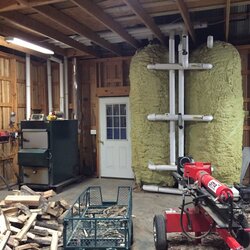I had access to a trailer to haul them with, and a front end loader to move them around with when they got here. I stacked them with that just outside my basement door, on dollies, then rolled them right into place and worked them off the dollies with a combination of floor jack, pallet jack, pry bars & blocks. (Some pics in my install thread in my sig). Preparation, I pressure washed them out with a bent wand (don't think I had to, they were pretty clean), after leaving open in yard with wind blowing thru them for a couple weeks (don't think I had to do that either but anyway). Then I marked on them with a sharpie where I wanted fittings welded & what to weld, and loaded up again & trucked them to my welder along with fittings I got at the plumbing supply house. Went back & got them when he finished. Charged a couple hundred. Couple hints - make sure you don't get cast fittings (I thought I got good ones but accidentally ended up with a couple cast ones that caused problems later - try using 12" black iron nipples cut in half), and don't get any more fittings put on than necessary. See what they come with & make use of those best you can & go from there. You can see in my pics, but I didn't get any stacking brackets welded on - I just used some 6x & 4x lumber. Was easier for me to do that. Some have stacked on pallet racking too. If you can get them home & in place, you could get them welded together while they're at the shop, but they're a lot harder to move around after that. Even stacking my 330s was a bit tricky, things are heavy and like to roll around.
And another hint - don't bother painting them. I did that, and they sure looked sexy after, but did they ever stink the house up after I got heat in them. I did use cheap paint though...


